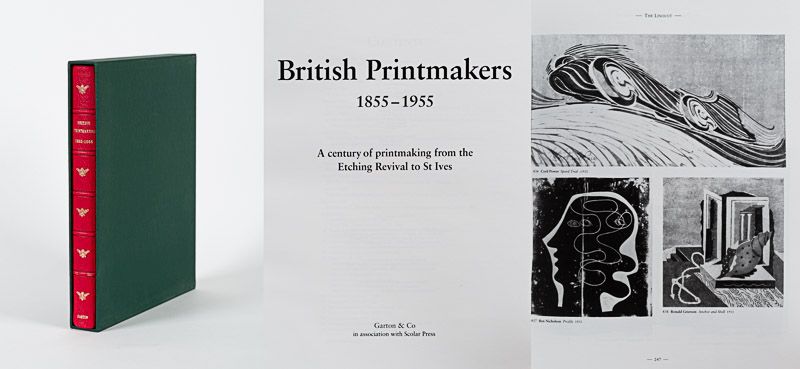Garton, British Printmakers - 1855-1955.
British Printmakers – 1855-1955. A Century of Printmaking from the Etching Revival to St Ives.
Special Collector’s Edition / Limited to 25 copies with Suite/3 prints. Devizes, Garton & Co, 1992. 26 cm x 32.5 cm. 326 pages. 585 illustrations. Hardcover / Publisher’s original quarter-leather with green buckram boards and raised bands. Gilt lettering on spine. Top edge gilt. With original green-cloth slipcase. Including the additional folio-suite of 3 prints: 1. ‘Nude with Pillow’ woodcut by John Nash / 2. ‘Abstract Flower Design’ by Enid Marx / 3. ‘Old Tree’ by Reynolds Stone. Near fine condition. Very rare edition of a stunning volume, excellently presented.
Includes, for example, the following: Introduction / Artist’s Biographies – Chapter One: Wood Engravings by Rodney Engen, art historian and author / Chapter Three: Lithography from c1875 to the 1920s, Prof Kemille Moore, Division of Art, University of North Carolina at Wilmington / Chapter Five: The Linocut, Alan Guest / Chapter Eight: The Monotype, Gordon Samuel, Director of the Redfern Gallery, London / Appendices I: Senefelder Club 1908-1934 – II: World War I Efforts and Ideals 1918 – III: Printmakers who also exhibited at the International Surrealist Exhibition, New Burlington Galleries, 1936 – IV: Contemporary Lithographs 1937-8 – V: Artists’ International Association (AIA): Everyman Prints 1940 – VI: A Salvo from Russia – Surrealist Prints 1942 – VII: World War II – VIII: School Prints 1946-51 – IX: Lyon Prints 1947-55 – X: The London Society of Painter-Printers – XI: Festival of Britain Prints 1951 – XII: Coronation Series 1953 – XIII: Exhibition of Corsham Lithographs at Dartington Hall 1955 – XIV: Guinness Prints 1956-c1957 etc
This book has been designed to provide a resource of information about the developments in British printmaking which started in the middle of the nineteenth century and continued into the middle of the twentieth; it also hopes to provide a point of departure for further study. The dates for the century (1855-1955) are not chosen at random. Original printmaking was not always well regarded and was in danger of extinction in Britain during the second quarter of the 19th century. The middle-1850s saw the beginnings of a revival of original printmaking in etching. The founding of the Society of Painter-Etchers in 1880 gave this development momentum. New developments and advances in lithography and the monotype from the 1900s onwards and the influence of wider artistic changes and different traditions reinvigorated printing as a potent means of artistic expression rather than mere reproduction.
The book is devoted to the artist-printmaker. The use of the term ‘print’ is so wide that for 150 years some of those involved with it have sought to prefix the word in order to show that it is they (rather than others) who have expressed their own ideas by use of printing. Ther term used in France, peintre-graveur, became here painter-etcher. In the 1940s, the term painter-printer was widely used. The word ‘painter’ was used to denote the artist’s own creativity in printmaking rather than to describe someone who painted in oils and also made prints.
In consequence, therefore, this work does not deal with categories of printmaking which may be described as decorative, topographical, naval and military, sporting, natural history, caricature, book or perdiodical illustration, bookplates, and reproductive printmaking. This is in no way to belittle some very remarkable work made in these areas and it is a pity that, for example, someone as talented as Edward Lear should have to be excluded but he is an artist among many others whose work in printmaking falls outside the subject in hand.
The text commences with an A-Z of artists we considered important or relevant to the period. It continues with essays describing developments in the different media which are followed by illustrative sections laid out chronologically.
- Keywords: 19th Century · 20th Century · Art – Rare · Art History · Books / Art · British · British Art · Catalogue Four – International Art · English Art · English Artist – Monograph · Inanna Modern – Art Books · Limited Edition · Limited Editions · Printing · Printing History · Rare Books · Victorian Art · Victorian Era
- Language: English
- Inventory Number: 120360AB
EUR 1.480,--
© 2025 Inanna Rare Books Ltd. | Powered by HESCOM-Software


















